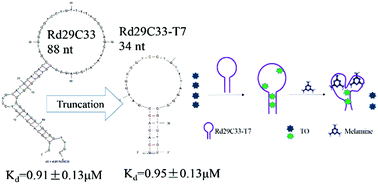Label-free fluorescence detection of melamine with a truncated aptamer†
Abstract
The 2008 Chinese milk scandal caused by the adulteration of melamine encouraged the public to pay attention to melamine detection in milk products and other food stuffs. To allow simple and rapid detection of melamine, we previously isolated an 88 nt melamine aptamer (called Rd29C33) using the structure-switching SELEX. However, this 88 nt oligonucleotide is costly to synthesize, and may also complicate the rational design of biosensors for melamine detection. To overcome this obstacle, we truncated Rd29C33 at several sites, and a 34 nt Rd29C33-T7 melamine aptamer was finally found to show comparable binding affinity and better selectivity to melamine compared to the original 88 nt Rd29C33. Furthermore, a label-free bioassay method for melamine detection was designed by using Rd29C33-T7 and thiazole orange (TO). The addition of melamine to a mixture of Rd29C33-T7 and TO caused the release of TO from Rd29C33-T7, resulting in a decrease of the fluorescence intensity of the solution. A detection limit of 0.12 μM for melamine was achieved using this label-free method. Good recovery ranging from 82.6% to 97.2% for melamine detection in whole milk samples suggested the promise of this bioassay method for application in monitoring melamine in real food stuffs.


 Please wait while we load your content...
Please wait while we load your content...